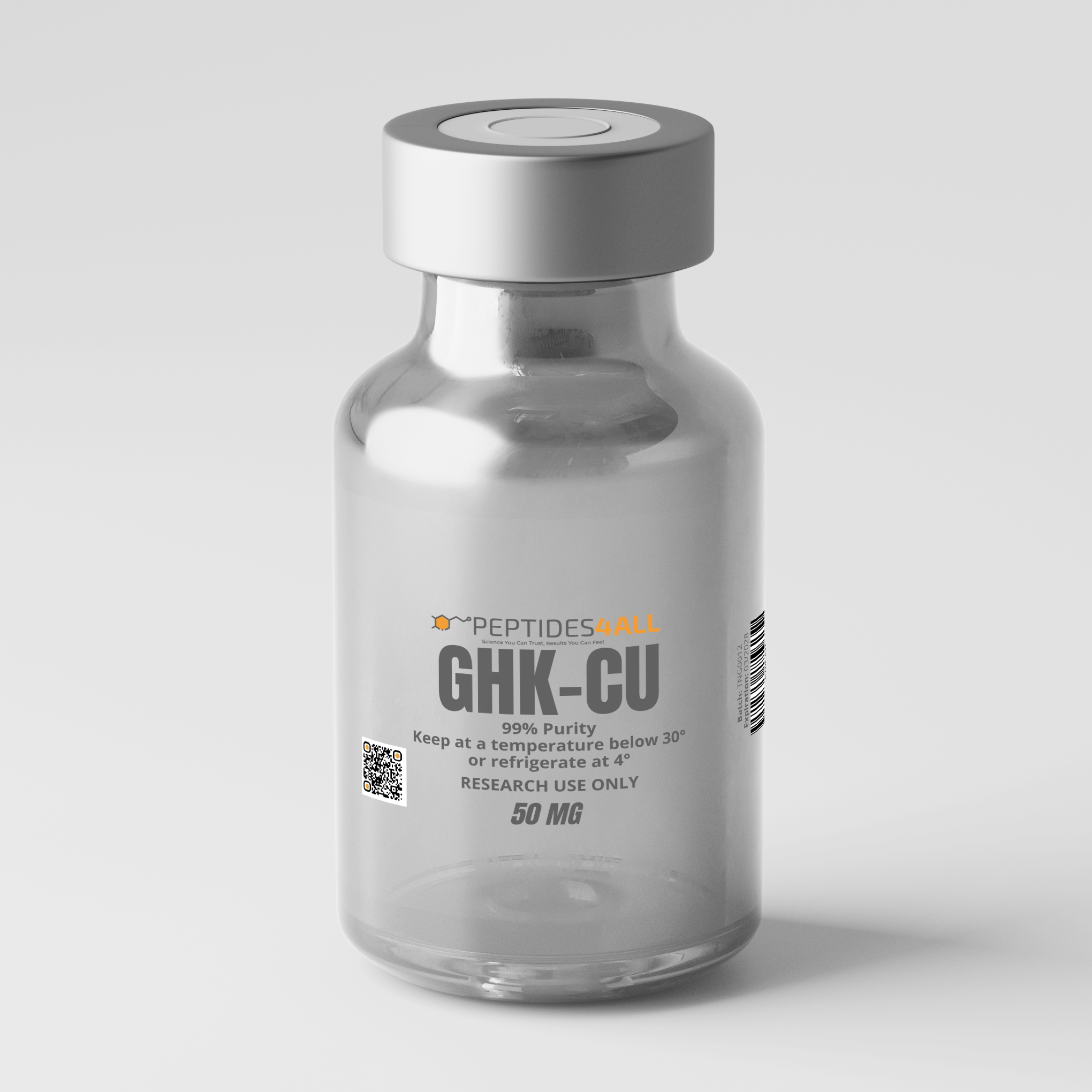PEPTIDES4ALL GHK-CU (Copper Tripeptide-1) – Regenerative & Anti-Aging Research Peptide
PEPTIDES4ALL GHK-CU (Copper Tripeptide-1) is a naturally occurring human tripeptide complex (glycyl-L-histidyl-L-lysine bound to copper(II)) renowned for its broad regenerative, protective, and genomic effects.
Originally isolated from human plasma in 1973, GHK-CU was identified as a key endogenous signal molecule that declines sharply with age, paralleling reductions in tissue repair, skin elasticity, and antioxidant capacity (PMC6073405).
This decline has made it a cornerstone molecule in research focused on cellular rejuvenation, wound healing, and gene reprogramming associated with youthful biological function.
At the molecular level, GHK-CU acts as a systemic modulator of tissue remodeling and cellular communication. By chelating copper ions, it activates numerous metalloenzymes and growth pathways involved in collagen synthesis, angiogenesis, and antioxidant defense (MDPI Cosmetics, 2018).
Its influence extends beyond the extracellular matrix: transcriptomic studies show that GHK-CU can reset over 30% of the human genome expression profile, down regulating genes linked to inflammation, fibrosis, and cancer progression, while upregulating those involved in repair, antioxidant activity, and neuronal growth (PMC4508379).
Research demonstrates that GHK-CU enhances wound closure, fibroblast proliferation, and extracellular matrix restoration, while reducing oxidative stress and pro-inflammatory cytokine signaling.
These combined effects make it a potent model for studying tissue regeneration, anti-aging processes, radiation protection, and organ recovery. In dermatological and anti-aging research, GHK-CU is recognized for stimulating collagen and elastin synthesis, improving skin firmness, and reversing photo-aging markers, positioning it as one of the most biologically active small peptides known in human regenerative biology (PMC6073405).
Beyond the skin, studies indicate that GHK-CU provides systemic antioxidant and organ-protective benefits. In preclinical models, it reduced pulmonary inflammation and improved outcomes in acute lung injury, underscoring its potential in multi-organ tissue resilience (MDPI Cosmetics, 2018).
This multi-faceted biological profile has established GHK-CU as a benchmark peptide for exploring copper-dependent regenerative signaling, oxidative stress mitigation, and age-related decline reversal.
With its high purity and reproducible biological activity, PEPTIDES4ALL GHK-CU offers researchers a powerful model compound to investigate the mechanisms underlying skin repair, fibrosis modulation, genomic reprogramming, and antioxidant defense — a molecular bridge between regenerative medicine and cellular longevity research.
Scientific Evidence & Research Findings
-
Wound Healing & Tissue Regeneration – GHK-CU accelerates wound closure, stimulates angiogenesis, and enhances collagen and elastin production in skin and connective tissues. https://pmc.ncbi.nlm.nih.gov/articles/PMC6073405/
-
Skin Rejuvenation & Anti-Aging Effects – Clinical studies have shown improved skin density, reduced fine lines, and enhanced elasticity after GHK-CU application. It also stimulates fibroblasts to produce extracellular matrix components. https://pmc.ncbi.nlm.nih.gov/articles/PMC6073405/
-
Anti-Inflammatory & Antioxidant Protection – GHK-CU reduces pro-inflammatory cytokines (TNF-α, IL-6) and lowers oxidative stress by boosting antioxidant defenses such as superoxide dismutase (SOD). https://www.mdpi.com/2079-9284/5/2/29
-
DNA & Radiation Repair – In irradiated fibroblasts, GHK-CU restored proliferative vitality and improved DNA repair responses, indicating potential use in recovery from oxidative and radiation damage. https://pmc.ncbi.nlm.nih.gov/articles/PMC6073405/
-
Lung & Organ Protection – Preclinical studies suggest GHK-CU reduces inflammation and cellular infiltration in models of acute lung injury.
https://www.mdpi.com/2079-9284/5/2/29 -
Genomic Modulation – Transcriptome analysis shows GHK-CU can reset thousands of human genes, turning off those associated with cancer progression while upregulating repair and regeneration pathways. https://pmc.ncbi.nlm.nih.gov/articles/PMC4508379/
Key Research Benefits & Applications
-
Accelerates Wound Healing: Promotes fibroblast proliferation, angiogenesis, and extracellular matrix synthesis, facilitating rapid tissue repair and remodeling.
-
Stimulates Collagen & Elastin Production: Enhances skin firmness, elasticity, and structural integrity through activation of key regenerative enzymes and copper-dependent pathways.
-
Gene Expression Modulation: Regulates thousands of human genes, down-regulating pro-inflammatory and fibrotic pathways while up-regulating those linked to repair, antioxidant defense, and neuronal growth.
-
Potent Antioxidant & Anti-Inflammatory Action: Reduces oxidative stress and cytokine signaling (e.g., TNF-α, IL-6) by increasing superoxide dismutase (SOD) and other antioxidant enzymes.
-
DNA & Radiation Damage Mitigation: Restores cellular vitality and genomic stability after oxidative or radiation exposure, supporting recovery from cellular stress.
-
Systemic Organ Protection: Demonstrates anti-inflammatory and cytoprotective activity in pulmonary and connective tissue models, highlighting potential relevance for multi-organ resilience.
-
Dermatological & Anti-Aging Applications: Serves as a model compound for skin rejuvenation, scar reduction, and photo-aging reversal, making it a benchmark peptide in regenerative and cosmetic research.
Presentation & Handling
- Form: Supplied as lyophilized peptide in sterile vial.
- Reconstitution: Use bacteriostatic water or 2% procaine; swirl gently (do not shake vigorously).
- Storage: Store at –20 °C, protected from light and moisture. After reconstitution, use according to research protocols and handle under sterile conditions.
Intended Use
For research purposes only. Must be handled in accordance with institutional protocols and ethical guidelines.
